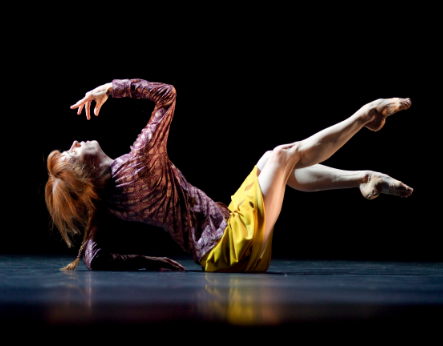
To American ballet fans younger than 35 or so, Sylvie Guillem is a mythical creature. We missed her years as the star of first the Paris Opéra Ballet and then the Royal Ballet. Later, when she stepped sideways into contemporary dance, her concerts rarely made it across the Atlantic.
But we all feel we know her anyway. We know her onscreen -- on grainy VHS tapes and (eventually) in grainy YouTube videos. And those spectral visions were enough to hook us all.
Guillem is, firstly, The Body: long, lissome, harmoniously proportioned. Diehards could write poetry about her crescent-moon feet alone. But her allure transcends those natural gifts. There is an elegant ease, almost nonchalance, to her dancing. Like all true stars, she doesn't announce her talent. It's just there -- undeniable, ineffable.
This week Guillem, a totally unconvincing 47, brought her repertory program 6000 miles away to the David H. Koch Theater in a presentation by The Joyce Theater Foundation. Wednesday night marked the first time I saw her dance live. There was no classical ballet on the program. But the two works she performed made it clear that she is still at the height of her technical powers.
Of course she is. She's Sylvie Guillem.

Sylvie Guillem in Mats Ek's Bye. Photo by Lesley Leslie-Spinks.
6000 miles opens with William Forsythe's Rearray, a duet for Guillem and La Scala Ballet principal Massimo Murru. (Guillem commissioned it, along with the closing work on the program, Mats Ek's Bye, for 6000 miles' premiere last year.) Rearray is classic Forsythe: a stop-and-start, deconstructed riff on ballet, informal, teasing. There are periodic blackouts, unconnected to the pauses in David Morrow's halting score for strings, which Guillem and Murru, unconcerned, ignore. One moment they're holding gorgeous classical arabesques; the next they're bobbing up and down like bullfrogs on a log. Sometimes they give it all up and walk offstage.
This is a style that Forsythe pioneered with Guillem herself 25 years ago, in the groundbreaking In the Middle, Somewhat Elevated. Murru, sinuous and plastic, is a fine foil for Guillem, but Guillem still does Forsythe better than anyone else. She understands its sense of causal risk. Its cheekiness, too: At one point Guillem, supported at the wrist by Murru, holds an extended développé to the side, then releases Murru's hand to show off her balance -- just as Aurora does in The Sleeping Beauty's Rose Adagio. Remember, Guillem asks slyly, when I used to do this?
Sandwiched in the middle of the program is Jiří Kylián's 27'52", valiantly performed by Nederlands Dans Theater alumni Aurélie Cayla and Lukas Timulak. The work is doomed by a confluence of Eurotrash clichés: a vaguely melodramatic premise, a synthesized soundscape that includes mysterious French phrases, gratuitous nudity. Kylián is so much better than this. He can conjure seamless pas de deux of boggling intricacy. But not only is the partner work in 27'52" duller than Kylian's best, it also feels impotently, pointlessly violent. Timulak holds Cayla savagely by the top of her head; he shoves her repeatedly, and repeatedly she attempts to ignore him, retreating into a sequence of neurotic tics, until the abuse overwhelms her. Finally both bury themselves under pieces of rubber marley flooring, to everyone's relief.
Luckily Bye is an excellent palate cleanser, giving us 20 blessed minutes of Guillem alone onstage. At the center of Bye is a sweetly funny party trick: It begins with a life-size projection of Guillem on a small screen. When the avatar's hand reaches beyond the screen, Guillem's real hand appears, to the audible delight of the audience. This precision-timed peekaboo game, set to a Beethoven piano sonata, continues for a while, with a foot, an arm, a head emerging, until finally Guillem steps into full view. It's an Alice in Wonderland moment -- there's the sense that the screen is Guillem's real world, and the stage some inner landscape, a private space.
Dancewise Bye is lightweight; Ek is not a technical choreographer. He also tends to create very human humans onstage, and trying to convince us that Guillem is a flawed, awkward being will always be a hard sell. But there's something perfect about Bye's central motif. At the end of the piece, after a noodly little "I don't want to" solo, Guillem steps back behind the screen; her avatar reappears in the projection. And there she is again: the Guillem we grew up with, on video.
--------
A former dancer and choreographer, Margaret Fuhrer is an associate editor at "Dance Spirit" and "Pointe" magazines.